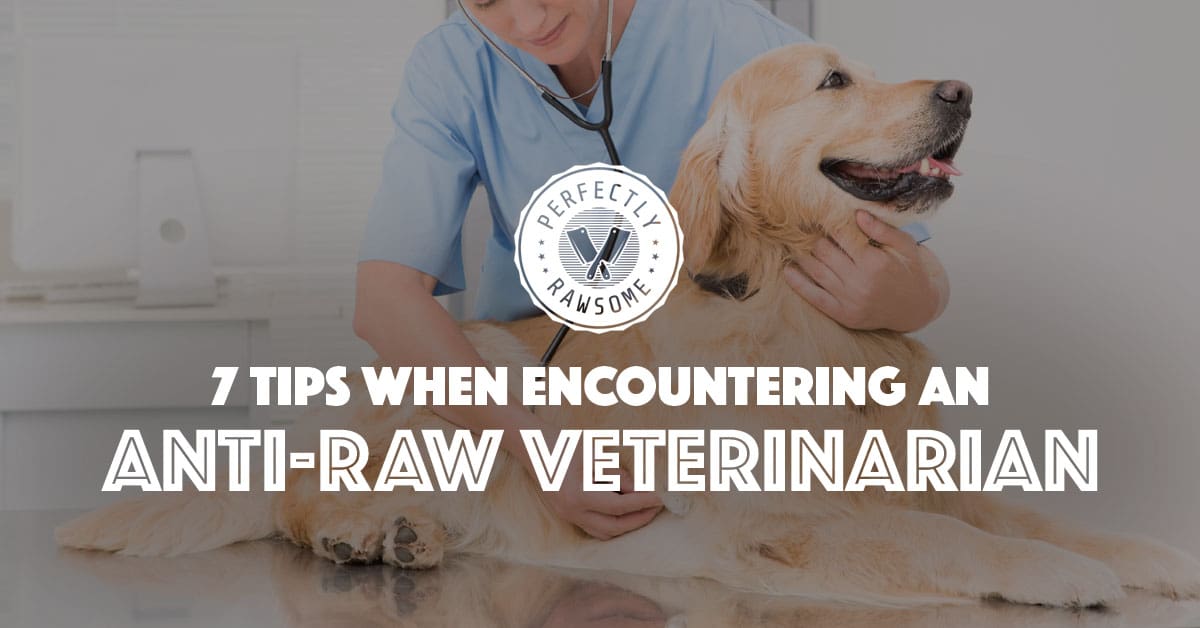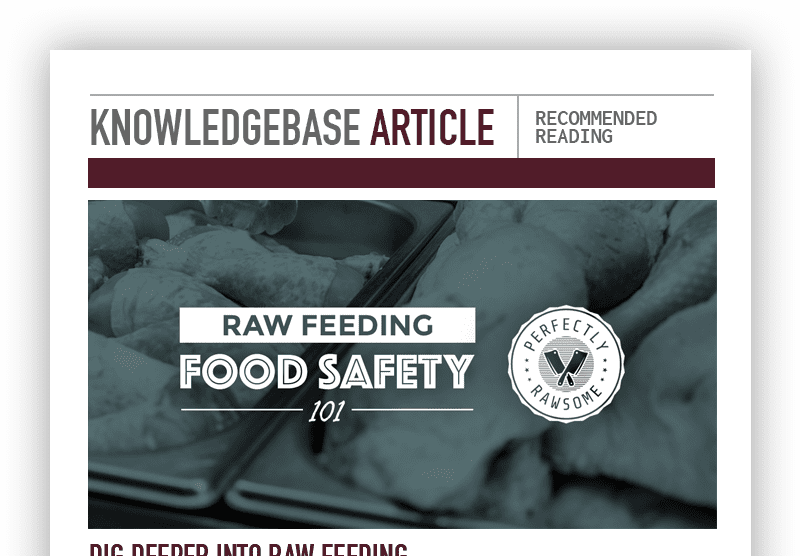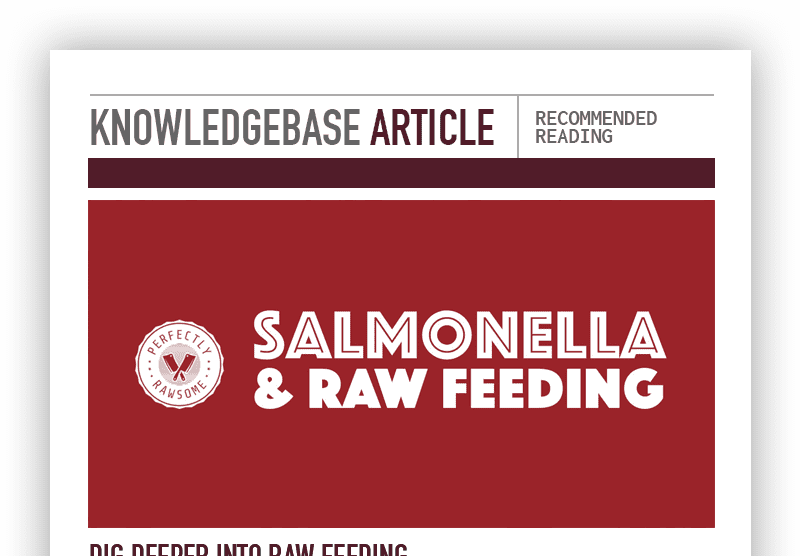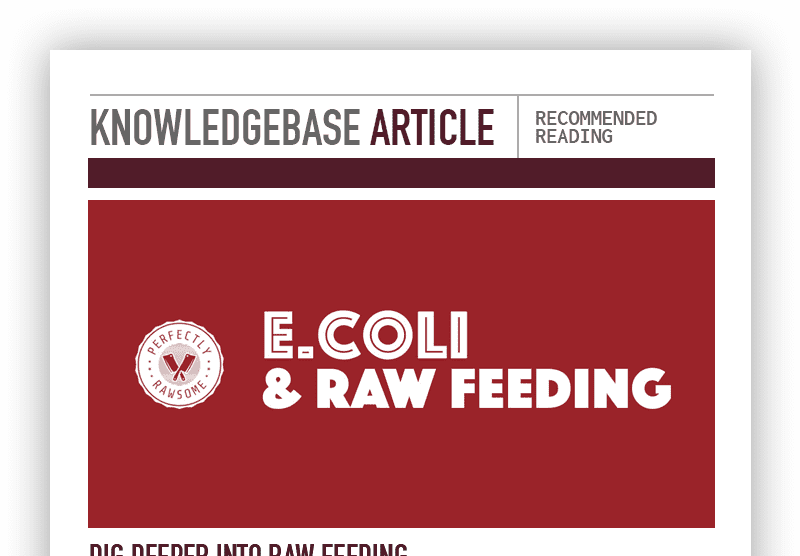Encountering a highly opinionated and pushy anti-raw veterinarian can leave many pet parents feeling paralyzed and overwhelmed. However, interacting with veterinarians and their staff doesn’t need to be stressful and it is possible to cultivate a positive working relationship.
Understanding a veterinarian’s daily experiences provides perspective and the insight needed when encountering an anti-raw veterinarian. There are several considerations that should be taken into account in order to foster a respectful and productive discussion:
Respect
Always remain respectful when interacting with a veterinarian, vet tech, and their administrative staff.
Transparency
Never withhold information from a veterinarian. This includes all details about a home prepared diet.
Communication
Maintain an open line of communication with a veterinarian to discuss their concerns about the home prepared diet.
Boundaries
Pet parents are allowed to have personal boundaries about their pet’s diet. However, the veterinarian will have boundaries as well.
Collaboration
Ask the veterinarian for their suggestions for changes to the diet – their recommendations may be useful.
Patience
Time is one of the best teachers and patience is a necessary virtue. It can take time for vets to gain perspective that the raw diet is the ideal choice for dogs and cats.
Acceptance
Some veterinarians will not change their opinions about raw diets – and that's ok!

Respect
Always remain respectful when communicating with a veterinarian. Anxiety and stress are high in scenarios where a pet is injured or sick – maintaining composure and respect is the first step when encountering an anti-raw veterinarian.
The recommendation to exhibit respect extends to all veterinarians and their staff:
Primary Care Veterinarians
In order to achieve the title Doctor of Veterinary Medicine (DVM), a vet must achieve their bachelor’s degree and complete 4 years of veterinary school in addition to 1 year of residency. Therefore, a veterinarian is the expert when it comes to the health and medical treatment of dogs and cats.
While the primary caregiver has the final decision on their pet’s diet; a veterinarian is the medical practitioner on the pet parent’s team to help prevent, identify, and treat any injury or illness.
Technicians, Administration, & Other Staff
All veterinarians have their own staff to help provide their patients with quality care. Technicians, the administrative team, and all other employees are an extension of the veterinarian to ensure their clinic operates smoothly.
Pet parents will encounter vet techs and office staff just as frequently as the veterinarian, if not more often.
Transparency
Always disclose all information about a dog or cat’s home prepared diet even if the veterinarian is anti-raw. Do not lie or withhold information from a veterinarian. Veterinarians need to know everything about their patient when assessing their health and providing treatment.
It is important to provide detailed dietary information rather than using vague descriptions to avoid misunderstandings:
Diet Type
There are three types of home prepared diets – raw, cooked, or a combination of the two. Always disclose what type of DIY diet a pet is consuming, daily intake, food ingredients, and how long the home prepared diet has been fed.
More often than not, traditional veterinarians are more accepting of cooked diets versus raw. However, it is not uncommon for all veterinarians to voice their concern over imbalanced homemade diets.
Supplementation
Additional supplementation is often unavoidable in DIY diets for various reasons. Always disclose all supplements provided and their feeding dosages. Some supplements can have contraindications with medications. Providing supplement information is necessary for a veterinarian to provide quality care and avoid medication interactions.
Communication
The majority of veterinarians want nothing but the best for their patients. Veterinarians who are strongly anti-raw often have the same common concerns for the health and wellbeing of the pet. Ask about their concerns and address them accordingly.
Maintain an open line of communication on the amount of research completed and show the vet that the home prepared diet is nutritionally balanced:
Nutritional Requirements
The National Research Council for Dogs and Cats (NRC) have established minimum requirements and recommended allowances for essential amino acids, fatty acids, fat soluble vitamins, water soluble vitamins, macrominerals, and microminerals based on the animal’s life stage.
Veterinarians are commonly aware of AAFCO and FEDIAF nutritional guidelines and may be unaware of NRC. However, AAFCO and FEDIAF utilize studies by NRC to establish their nutritional guidelines for dog and cat food.
Essential Nutrients in Fresh Food
All fresh food provides various nutrients. It is recommended to communicate what nutrients each ingredient contributes to the diet, starting with the ratio guidelines and what each category provides.
Nutritional data on most human grade food can be found on the USDA Food Search Database and should be used when discussing the nutrient composition of a home prepared diet with a veterinarian. However, it is important to remember that the USDA database does not include data on bones, exotic meats, off cuts, or whole prey.
Common Deficiencies
Home prepared diets have nutritional deficiencies if strategic ingredients or supplements are not fed. Acknowledge these known deficiencies and how the ingredients and supplements within the home prepared diet address these problems.
Veterinarians often treat medical conditions that are a direct result of an improperly balanced diet. Therefore, they frequently have an understandable bias against DIY diets. It is important to be educated and able to demonstrate that the homemade raw or cooked diet is nutritionally balanced.
| Nutrient | Ingredient | Dog | Puppy | Cat | Kitten |
| ALA | Seeds | ✓ | ✓ | ✘ | ✘ |
| B Vitamins | Yeast | ✴ | ✴ | ✓ | ✓ |
| Biotin | Eggs | ✘ | ✘ | ✓ | ✓ |
| Calcium | Raw Meaty Bones | ✘ | ✓ | ✘ | ✓ |
| EPA+DHA | Fatty Fish | ✓ | ✓ | ✓ | ✓ |
| Iodine | Kelp | ✓ | ✓ | ✓ | ✓ |
| Iron | Spleen | ✘ | ✓ | ✴ | ✓ |
| Manganese | Green Tripe, Blue Mussel | ✓ | ✓ | ✓ | ✓ |
| Vitamin D | Fatty Fish | ✓ | ✓ | ✓ | ✓ |
| Vitamin E | Supplement | ✓ | ✓ | ✓ | ✓ |
| Taurine | Supplement | ✘ | ✘ | ✴ | ✴ |
| Zinc | Oysters | ✓ | ✓ | ✓ | ✓ |
✴ = Conditionally deficient and may require supplementation
Bacteria Conscious
Veterinarians routinely use bacteria as an objection against raw diets for the protection of the pet parent, their family, and the pet. However, there is a low number of owners who reported suspected transmission of food borne pathogens from raw meat-based diets. There were zero confirmed cases reported – 11 households reported probable transmission, 20 households reported possible transmission, and 5,580 households were not considered to have experienced potential transmission. (Yamka, Adams, Cammack, 2021)
It is highly recommended to utilize food safety practices advised by the FDA when feeding a DIY raw diet to a dog or cat to prevent cross contamination and not to feed spoiled raw meat. However, some veterinarians will not accept food safety protocols as a method to reduce bacteria risks. There is no such thing as sterile food unless it is pasteurized and there are multiple High Pressure Pasteurized (HPP) raw foods that can provide an option to appease anti-raw veterinarians.
Parasite Free
It is often mentioned that pets who consume a raw diet require routine deworming. However, raw diets made from human grade meat do not pose the risk of parasitic infection due to their USDA regulatory inspection. The CDC recommends freezing meat less than 6 inches thick for 20 days at 5°F (-15°C) to kill any trichinosis worms; therefore wild game and fish should be frozen for 3 weeks prior to feeding.
Additionally, feeding infected or spoiled meat is highly discouraged, as well as raw meat from wild carnivores, bears, and wild boar. Due to these precautions, a dog or cat should not encounter internal parasites due to consuming raw meat.
Boundaries
Establishing boundaries is recommended for pet parents to communicate their choices for their pet’s care and diet. It is important to remain respectful when communicating boundaries and reflect upon the worst case scenarios veterinarians see on a day to day basis.
Fresh Food Only
Humans inherently know that a fresh food diet is far superior to processed food. However, there is a massive disconnect between this accepted belief system for humans and the processed diets that traditional veterinarians recommend for dogs and cats.
Establish a “fresh food only” boundary when encountering an overly pushy anti-raw veterinarian. Balanced diets are possible with fresh food, raw or cooked, and there is no reason to switch to processed food if the home prepared diet provides all essential nutrients necessary for optimal health.
Diet Adjustments for Clinic Stays
There are times when a pet needs to have an extended stay at the veterinary clinic. Anti-raw veterinarians will often request that the pet consume processed food while staying at the clinic. Switching to a processed diet is not something that most fresh food feeders are comfortable with.
Occasionally a temporary compromise is necessary. Alternative fresh food diets can be fed in times of extended clinic stays instead of processed foods. Home cooked diets with a calcium supplement or commercial freeze dried raw are options to appease anti-raw veterinarians during a clinic stay.
Collaboration
Veterinarians may have suggestions for resources or changes to make to a homemade diet. These recommendations will often come from their professional experiences and nutritional biases. Remain open to suggestions and to exploring those recommendations.
The recommendations do not always have to be utilized, but the information provided by a veterinarian could shed light on possible improvements to make to the home prepared diet:
Ingredient & Supplement Recommendations
If the home prepared diet includes whole raw meaty bones, prepare for the recommendation to stop feeding all bones and provide a calcium supplement. This comes from multiple experiences of veterinarians treating pets with slab molar fractures, intestinal blockage, or intestinal perforation from pet parents who fed dangerous weight bearing and cooked bones. It is important for pet parents to only feed safe raw meaty bones and respectfully communicate this to the veterinarian.
However, a veterinarian may recommend a specific ingredient or supplement to the home prepared diet based on the previous information discussed. It is important to remember that the recommendations provided by a veterinarian are made with the best intentions for the pet’s health and safety.
Professional Diet Consultation
Some veterinarians will fully admit their lack of knowledge about canine and feline nutrition as a reason for advising against home prepared diets. Therefore, they may recommend working with a canine or feline nutritionist to ensure the home prepared diet is nutritionally balanced.
A qualified professional Canine and Feline Nutritionist provides formulated diets for the individual pet’s requirements and provides detailed nutritional reports to illustrate the recipes are compliant to a nutritional standard (NRC, FEDIAF, AAFCO). The reports provided by the nutritionist can be submitted to the pet’s veterinarian for their records.
Patience
Time is one of the best teachers. If a raw diet is nutritionally sufficient, the condition and health of the pet over time will be evidence of the benefits. Additionally, veterinarians may bring up the discussion of the dog’s or cat’s raw diet on more than one occasion; but maintain patience knowing that time will show that a balanced raw diet is safe to feed dogs and cats:
Optimal Health
A balanced fresh food diet provides the body with an ideal diet that supports optimal health. This results in fewer illnesses and disease which is a major testament to a fresh food diet. However, the only way to prove this is to allow time to display the benefits to an anti-raw veterinarian.
Acceptance
Finding a raw-friendly vet can be difficult. It is highly encouraged to maintain a relationship with the pet’s primary veterinarian regardless of their stance on home prepared raw diets if a pro-raw vet is not available. An open line of communication and respect will go a long way if due diligence has been done to ensure the home prepared diet is nutritionally sufficient.
Accepting that a veterinarian will not change their stance on a raw diet is disappointing for many pet parents when a pro-raw vet is not available in their local area. However, pet parents can choose to work with multiple veterinarians – specifically pro-raw veterinarians through phone or video consultations.
CLOSING COMMENTS
There is no reason to be fearful of a veterinarian or withhold important information from them – even if the vet is anti-raw. Pet parents should take the steps necessary to develop a positive working relationship with their veterinarian and their staff whenever possible:
Always remain respectful.
Be transparent about the diet.
Maintain an open line of communication.
Remain clear about personal boundaries.
Extend the olive brand for collaboration.
Patience to allow time to teach.
Accept what cannot be changed.
These communication tools are intended to guide pet parents through the potentially difficult conversations with an anti-raw veterinarian. They also have greater implications for the raw feeding community as a whole. While raw feeding is still a new concept to many traditional veterinarians, educated pet parents can create a ripple effect among veterinarians and a shift in the pet food industry. It’s important to represent the raw feeding community positively by following the steps outlined in this article. However, if a veterinarian chooses to dismiss the efforts taken to provide a balanced home prepared diet and continues to exhibit overly pushy and defensive behavior, it is a clear sign to search for a new veterinarian that will respect their client regardless of their professional biases.
Citations:
Yamka, Adams, & Cammack. (2021). Low number of owner reported suspected transmission of foodborne pathogens from raw meat-based diets fed to dogs and/or cats. Pathogen Case. Published. https://www.linkedin.com/posts/ryanyamka_cammack-et-al-2021-asas-annual-meeting-activity-6821555201665716224-0o65?fbclid=IwAR1QHFDoJRU7PJEKupZrJdm2WlqllrbifXHasa5GdegfVLxcMquEKogtJtUa



